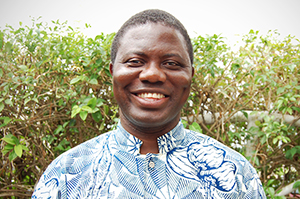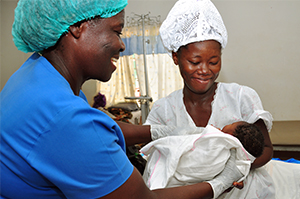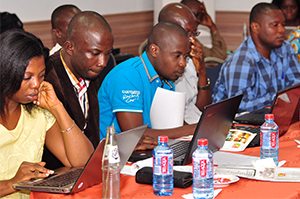
Christian Health Association of Ghana Chooses iHRIS for Managing and Supporting Health Workers
The Christian Health Association of Ghana (CHAG) has begun using the iHRIS software to improve management and support of over 13,500 health workers posted in its health facilities across the country.
With 184 facilities primarily located in hard-to-reach locations—where half the population of Ghana lives—CHAG is a significant provider of health care in the country. According to Samuel Nugblega, CHAG’s technical adviser on leadership, governance, and human resources, CHAG provides 20% of all out-patient and 35% of all in-patient care. Nugblega and his colleagues believe that using health workforce data from iHRIS will improve CHAG’s human resources planning and facility management, as well as boost the quality of service delivery.
CapacityPlus develops the core iHRIS software for tracking, managing, and planning the health workforce, and releases regular updates with improvements and new features. Because the software is free and open source, 19 countries, including Ghana, have already customized it for local needs.
Improving human resources management
“I have the passion for human resources,” says Nugblega, “Because that’s what turns everything around health.”
Four years ago he started the Human  Resources Department at the CHAG Secretariat. Now he leads a seven-person team that shares his enthusiasm. “We think human resources are the most important resources we should be looking at,” he says. “We are beginning to see it’s an asset we have to improve rather than a cost we want to minimize. And that’s why everybody is getting excited about this now.”
Resources Department at the CHAG Secretariat. Now he leads a seven-person team that shares his enthusiasm. “We think human resources are the most important resources we should be looking at,” he says. “We are beginning to see it’s an asset we have to improve rather than a cost we want to minimize. And that’s why everybody is getting excited about this now.”
Nugblega thinks the biggest challenge his team faces is having accurate and accessible data on health workers. “We currently do not have comprehensive data or a comprehensive information management system for our staff,” he explains.
Nugblega and his colleagues recognize that there are not enough health workers in the country, limiting the ability to increase access to care. Ghana has only 13.6 doctors, nurses, and midwives for every 10,000 people, well below the WHO’s recommended minimum of 34.5 per 10,000. There is also an unequitable distribution of health workers in the country—about 40% percent of health workers are located in the capital city. This trend for health workers to be concentrated in urban areas is also true for CHAG. “So one facility has a good number of staff and another facility does not,” Nugblega points out. “If you can manage your staff well, if you can distribute your staff well, you need data on all of them.”
CHAG currently relies on a combination of paper-based systems and Excel spreadsheets to track health worker information. Each facility does something different, making it difficult for Nugblega and his colleagues to analyze CHAG’s overall health workforce situation. Using iHRIS, they will be able to easily access information about where health workers are deployed and which facilities are in the greatest need of more workers, along with their qualifications, employment and salary history, and in-service training completed.  iHRIS fits into CHAG’s overall strategy for strengthening health workforce management. Other activities include developing a staffing norm for facilities that matches service delivery demands to inform health workforce planning; creating a standard HR manual; training facility managers on HR issues; and developing and applying an Occupational Tool for Assessing Performance, which includes a section based on CapacityPlus’s Human Resources Management Assessment Approach. CapacityPlus provides technical support for several of these activities.
iHRIS fits into CHAG’s overall strategy for strengthening health workforce management. Other activities include developing a staffing norm for facilities that matches service delivery demands to inform health workforce planning; creating a standard HR manual; training facility managers on HR issues; and developing and applying an Occupational Tool for Assessing Performance, which includes a section based on CapacityPlus’s Human Resources Management Assessment Approach. CapacityPlus provides technical support for several of these activities.
iHRIS capacity at the facility level
iHRIS is already being used in Ghana’s health sector to make the best use of the existing health workforce and plan for the future. The Ministry of Health is using it to manage approximately 6,300 central-level employees. Now three of the Ministry’s implementing agencies that provide health care—the Ghana Health Service, teaching hospitals, and CHAG—are adopting iHRIS. The Ghana Health Service just finished entering records for 6,662 health workers posted at its facilities in the Greater Accra Region, and is planning to roll it out to additional regions this year.
“We chose iHRIS because we believe that it is the best available system that can help us manage our human resources,” says Nugblega. But he stresses it’s important for all CHAG facilities to come on board, which will take some time. “We think data is required for accurate and relevant decision-making. But if we only have half of our data to work with, then the decisions that we make may not be far-reaching.” As a first step, CHAG held two workshops in March to train staff from 30 facilities. Human resource managers and health information officers learned how to enter and update employee information, set up a job structure to match their facility, assign staff to current positions, and run reports. Hospital administrators learned how to analyze those reports to identify vacancies and evaluate staffing needs. CapacityPlus facilitated the workshops along with local iHRIS champions and members of the CHAG Secretariat.
As a first step, CHAG held two workshops in March to train staff from 30 facilities. Human resource managers and health information officers learned how to enter and update employee information, set up a job structure to match their facility, assign staff to current positions, and run reports. Hospital administrators learned how to analyze those reports to identify vacancies and evaluate staffing needs. CapacityPlus facilitated the workshops along with local iHRIS champions and members of the CHAG Secretariat.
Since the workshop, the 30 participating facilities have entered a total of 3,500 records into iHRIS. Once all their health worker information is keyed in, they will share reports with the CHAG Secretariat. The Secretariat will use this information for health workforce management and planning, including making decisions related to recruitment, deployment, training and development, and rewards and compensation. CHAG will share the data with the Ministry of Health and other partners.
CHAG is planning similar workshops for staff working at its remaining facilities, with the goal of all facilities using iHRIS in the future. “Once that information is there, then the facilities will have the right people at the right place, doing the right work at the right time, giving them the right output. That's how we see it,” says Nugblega.
Help CapacityPlus spread the word about strengthening the health workforce. Follow us on Twitter and like us on Facebook.
Related items:
Photo 1 by Gracey Vaughn (Samuel Nugblega). Photo 2 by Carol Bales (a health worker at the Seventh Day Adventist Akumadan Health Centre hands a newborn baby to her mother). Photo 3 by Carol Bales (workshop participants learn to run iHRIS reports).


